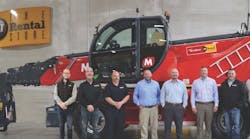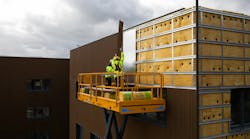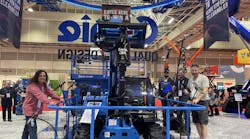By Tony Groat; Photos by IPAF
Mobile Elevating Work Platforms (MEWPs) play a pivotal role in various industries, offering a safe and efficient means of temporary access to elevated workspaces. That statement is true, but safe operations are dependent on people adhering to safe use practices outlined in industry standards and manufacturer’s operator’s manuals, including the identification of workplace hazards and developing safe methods of work to mitigate their risk.
The Need for Hazard Recognition
MEWPs are designed and manufactured for their intended purpose, but their safe use must be supplemented by good job management, safety control and the application of sound principles of safety, training, inspection, maintenance, application and operation.
OSHA’s 5a1 General Duty clause states, "Each employer shall furnish to each of his employees’ employment and a place of employment which are free from recognized hazards that are causing or likely to cause death or serious physical harm to his employees.”
Specific to mobile elevating work platforms (MEWPs), the ANSI/SAIA A92 standards require, “A safe use program specific to MEWPs shall be developed by the user and shall include… performing a site risk assessment to identify hazards, evaluate risk, develop control measures and communicate with affected persons.”
IPAF has developed a MEWP safe use plan guide to assist in users creating their plan. https://www.ipaf.org/en/resource-library/developing-mewp-safe-use-program-guide
Energized Power Lines – A Known Potential Hazard
IPAF collates incident reports received from around the world, from companies, individuals and IPAF members who share their experiences to allow others to work safer. By analyzing the data, it is evident incidents involving electrocutions and electric shocks have notably increased since 2015. The standout statistic is that reported incidents of electrocution are nearly always fatal. https://www.ipaf.org/en/resource-library/ipaf-global-safety-report
From 2012-2021 accident reports, IPAF identified that the top three industries for electrocutions and electric shocks globally were:
- In this period, we received 169 reports from 12 countries, with 179 people involved and 129 fatalities over the 10-year period. Vehicle-mounted (1b) MEWPs are the most common type of MEWP to be used for working in and around power lines, mainly owing to the ease of use of this type of equipment and the fact most distribution lines are normally accessible from roads.
- IPAF has not conducted investigations into deaths or serious injuries resulting from electrocutions or shocks; these investigations are normally carried out by enforcing authorities. Industry experts inform us that incidents normally occur when there is a lack of planning.
- MEWP accident data informs us that electrocutions and electric shocks are a common cause of death and serious injury. Working in the vicinity of power lines is a high-risk activity and must be planned and carried out safely.
In additional to IPAF accident data, the Electrical Safety Foundation International (ESFI) concluded from data published by the U.S. Bureau of Labor Statistics (BLS) and the U.S. Census Bureau for all workers that more than 45 percent of all electrical fatalities result from contact with energized power lines. While Electrical Occupations report on average 7.5 fatalities a year, Non-Electrical Occupations represent 43.2 fatalities per year.
This statistic points to non-electricians, with no intention of working on a power line, are exposed to the hazard and literally ignore the risk of electrocution while focusing on completing their task (e.g. roofing, painting, building maintenance, etc.). This highlights that carrying out a risk assessment and formulating a safe work plan before work commences is critical. It is also vital that all those involved in the use of MEWPs understand the safe work plan before work commences.
The number of reports from the period 2019-21 show an increase in the number of incidents involving electrocutions and electric shocks. There were at least 38 accidents reported in the IPAF portal within the U.S. alone during 2023 caused by electrocution or electrical shock.
A Real Life Example
A recent news report provided a graphic picture of the severity of an incident when a MEWP came too close to an energized line. The following summary of that news report is shared in the hopes readers will take hold of the importance of always planning when energized lines are in the vicinity of work.
A roofing company was accessing its work using a MEWP. "When they extended the lift, it came within about six inches of the high-voltage lines and arced to the equipment," reported the Fire Chief. Two men in the bucket and one man on the ground were then electrocuted. All three were seriously burnt and rushed to the hospital for treatment. The shirts of all three men were burnt off while they were still wearing them. A two-foot hole was blown into the ground and the MEWP was shorted out, trapping the two men in the bucket.
As this incident reports, the risk from this hazard is extremely high and you do not have to come in direct contact with an energized line, as electricity can be discharged or arc across to a conductor (the MEWP or occupants). The key to planning is to stay a safe distance away. While we have well established Minimum Approach Distances (MAD) based on the line voltage, that guidance is meaningful for individuals who are qualified and know what voltage is in the lines.
Industry standards have simplified safety guidance for MEWP operators to stay at least 10 feet away from power lines with any part of their body, conductive object, or any part of the MEWP. As simple as that seems to be, a discouraging statistic is that nearly 60 percent of all annual fatalities over the past 40 years have consistently been through contact with energized power lines.
If a MEWP or platform occupant contacts energized power lines it can cause electrocution, electric shock, fire, or an explosion. The same effects can occur without contacting a power line by arcing or flashover of electrical energy to a conductor.
Why is This Happening?
OSHA and ANSI MEWP standards have long addressed the risk of electrocution and electric shock from energized power lines and have requirements for minimum safe distances from them. Despite these well-established requirements, MEWP operations still have electrocution as a leading cause of fatalities associated with their use. If the MEWP becomes energized, it becomes a risk for those in the vicinity on the ground.
Industry experts have identified the following as potential reasons for these incidents:
- Lack of planning and failure to identify power lines in your work area.
- The MEWP or its occupants inadvertently contacting power lines or entering an exclusion zone. An exclusion zone is the prescribed safety envelope area around live electrical power lines. Exclusion zone distances are specified by the Energy Supply Authority (ESA).
- Incorrect identification of power lines that are mistaken for telecommunication lines.
- Power lines that are hidden by vegetation or trees.
- Lack of awareness of the proximity of power lines.
- Complacency of the supervisor and MEWP operator assuming nothing will go wrong.
- Inadvertently operating the MEWP controls in the wrong direction or using the controls erratically.
How Can Electrocutions Be Prevented?
The recognition that a safe distance from overhead powerlines has been an existing requirement begs the question “How can MEWP operations be prevented from the risk of electrocution in MEWP operations?” Industry experts offer the following:
- At the planning for work at height stage, the energy supply authority should be contacted to inform them of your work location and what you intend to do. Work in the hazard area must not proceed until you have their authorization.
- Ensure there is a site risk assessment, and a specific rescue plan in place and that the task is appropriately supervised. The risk assessment and the safe work procedures must be communicated and understood by everyone involved in the task.
- Ensure everyone is qualified. Anyone involved in the safe use of a MEWP must be trained and have received a machine-specific familiarization.
- Check for warning signage attached to the pylon/pole.
- Treat all overhead lines and other electrical apparatus as live unless declared “isolated” and “safe” by the ESA.
- Use a spotter (also known as a ground person) to direct the movement of the MEWP.
- Always remain vigilant for the presence of power lines.
Emergency Measures to Take if a MEWP or Person Contacts a Power Line
Despite all regulations, training, and best efforts by many, an accident can occur. And that too requires planning regarding what to do in case of an accident. That has even greater importance with the hazard of electrocution when the consequences are severe, to include serious injury and death. In the absence of a rescue plan and training, people are thrust into an emergency response that can be traumatic, rushing in without understanding the dangers to others and themselves.
The following are suggested measures to have in your plan:
- Contact the emergency services and state: “This is an electrical emergency.” Take no action for rescue until the ESA confirms conditions are safe.
- Communicate with the occupants and assist them to remain calm and to stay in the platform. If possible, break contact with the power line before reversing the last movement.
- If a MEWP is in contact with an energized power line, the nominated ground rescue person must not touch any part of the MEWP as it could be live.
- The nominated ground rescue person must warn all others to KEEP AWAY FROM THE MEWP.
- Cordon off the area if possible.
- Communicate and have drills to prepare workers how to implement the plan if an emergency occurs.
Need to Amend Common Beliefs
You cannot travel far in the U.S. without seeing overhead power lines. There are more than 5.5 million miles of distribution lines in the United States and more than 180 million power poles. As they are all around us and even coming into our homes, it is easy to understand how workers may simply not see them as a threat and just blend into the background. That is a problem as they cannot be ignored.
Many believe that these lines are insulated, similar to wiring in our homes. They are not, rather, only covered with weather protection. Line contact with a MEWP creates a ground and electric flows or even arcs through the air if close enough.
You can often see birds resting safely on overhead power lines. The reason that birds can sit unharmed on power lines is that no current flows through them because, by sitting on one line only, they are not completing the electrical circuit. Yet, U.S. power lines has long been a significant cause of bird mortality, killing as many as 11.6 million birds a year, according to one study. It happens with larger birds, when two body parts—typically a wing, foot or beak—come in contact with two wires or a wire and ground source, shooting voltage through the bird.
A deadly perception that many carry is "I’ve worked near them many times before and nothing bad happened” so "it won’t happen to me”. Too many undertake unsafe practices and because an accident did not take place does not mean that activity was safe. The more times a worker performs an unsafe act without consequence, including no reprimand from the supervisor, the greater the perception that activity is OK. This is misinformation that one day can prove fatal.
If a Power Line is Nearby – Add Protection Into Your Plan
It is important to consider protection in your planning any time energized powerlines are in the vicinity of the project. Too often this hazard is not addressed because those planning the work do not consider nearby powerlines as part of their work or the powerlines are not directly in the area where most of the work is to be performed.
A risk assessment must consider the likelihood of contact or arcing with an energized line and the severity of consequences if that does occur. While one may evaluate the likelihood of contact low as power lines on site are far from the task to be performed, is there any chance the movement of the MEWP to or from the work site (or other scenarios) may approach them?
The risk assessment must simultaneously consider the severity of consequence from the hazard. Electricity can result in the highest level of consequence – serious injury or death. This high level of hazard in combination with a low risk raises the need for prevention.
IPAF’s 2023 safety campaign raised attention to this potential hazard when working with MEWPs. The campaign highlighted the high risk from energized power lines. The campaign has developed a guidance note “The Safe use of MEWPs in the Vicinity of Power Lines” as well as posters and toolbox talks, all available for a free download.
These are all available for free download. Stay Alert – Stay alive.
Tony Groat is North America regional manager for the International Powered Access Federation









